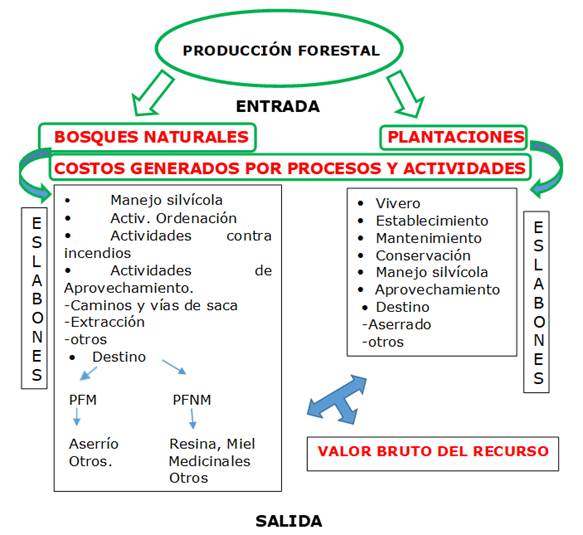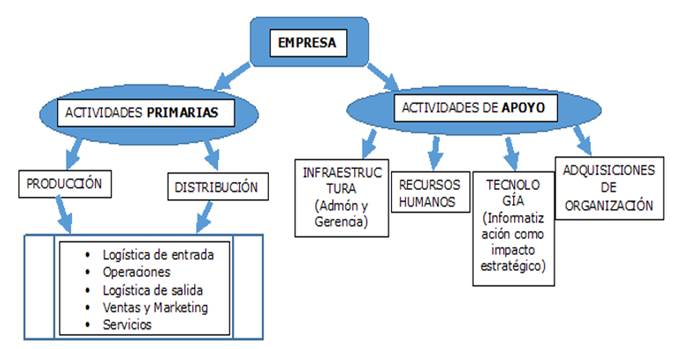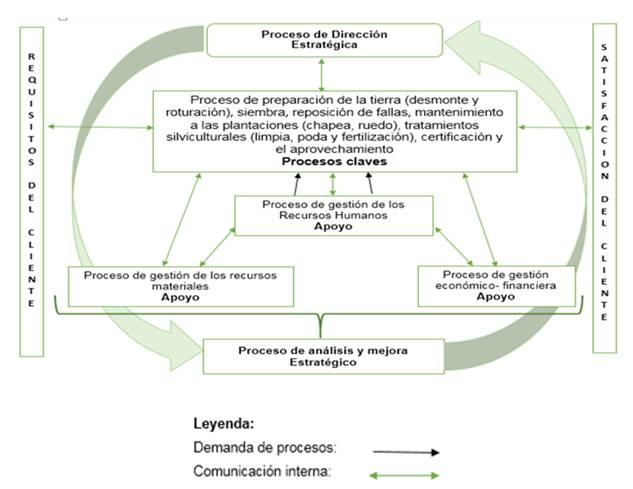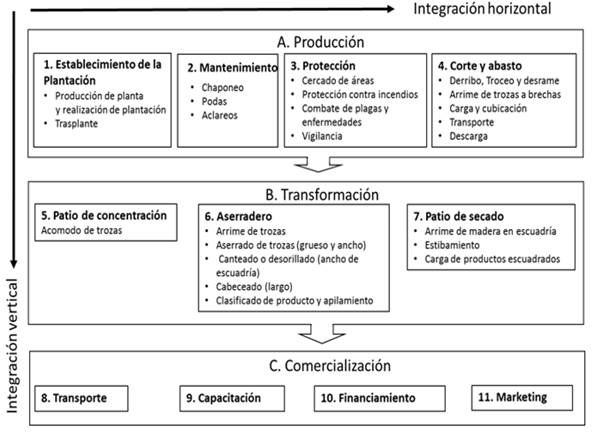Revista Cubana de Ciencias Forestales
ISSN 2310-3469
03--2022
Original article
A look at production by processes, key to sustainable forest management
1Universidad Estatal del Sur de Manabi. Ecuador.
2Universidad de Pinar del Río "Hermanos Saíz Montes de Oca". Pinar del Río, Cuba.
In any production process, if it is to be sustainable, the available natural, material and human resources must be used appropriately. The logistics of usage determines the effectiveness of the process and the achievement of the desired results. The objective of this study is to analyze the management of forestry production in terms of the productive chain, since its beginning in plantations or natural forests, to the marketing and business processes of forestry companies, going through different logistically structured and planned processes, related to the efficiency of sustainable forest management. In order to do so, theoretical methods of bibliographic search of the subject were used, supported by the productive chain model of a company in terms of value and results of research carried out. An alternative for management is presented, which can be applied in any forestry company.
Key words: Forest management and production by processes; Productive chain; Plantations; Natural forests.
INTRODUCTION
Conceptual framework
Forests, when managed sustainably, can play a crucial role in climate change mitigation and adaptation. In the broader context of sustainable development, sustainable forest management also contributes to food security, poverty reduction, economic development and rational land use (FAO, 2010).
When good forest management is carried out by those who have forests under their jurisdiction, the survival of the ecosystems is ensured, improving their environmental functions and ecosystem, socio-cultural and economic services, thus contributing to mitigation and/or adaptation to climate change, if it has a sustainability character (Medina, Rodríguez and Domínguez, 2021).
On the road to excellence, companies in the forestry sector must assume a management philosophy, in balance with the three dimensions of sustainability, taking into account the disturbances produced by elements of natural origin (such as fire, atmospheric phenomena, pests, among others), the use of the forest by man, as well as the business variables that influence its management, such as economic resources, technology, infrastructure and human resources (Pérez-Martínez, Fernández-Hernández 2021 and De La Nuez-Hernández, 2021b).
Among the forest management practices exposed by the Food and Agriculture Organization of the United Nations (FAO, 2011), mentioned by Medina, Rodríguez and Domínguez (2021), are:
Afforestation, reforestation and forest restoration. Seedbeds, germplasm banks and nurseries.
Increased forest cover in agricultural systems
(Agroforestry), rural landscapes and cities.
Increased carbon stocks and sequestration capacity through management practices.
Management of forest biodiversity.
Health and vitality of forests to reduce their vulnerability.
Intensification of integrated fire management systems.
Adaptive and sustainable practices of management and use of forests also as a hydrological resource.
Management of protected areas and wildlife.
Reinforcement of strategies to face new situations. Risk and adaptation studies.
Diversification of employment opportunities and livelihoods related to forest management.
Besides, the correct application of legislation and, normative and legal framework in general, as part of an efficient management with character of sustainability and confrontation to the changing climate, without forgetting the environmental education in all the related subjects, giving participation to communities.
If each of these practices is analyzed and executed within the corresponding process, forest management will undoubtedly be more effective and organized.
The forest production process consists of the following stages: production of plants (nursery); Plantation; Management; Maintenance and Administration; Harvest; Transportation; Raw Industry and Export; later supported by COFIBONE (2019), where each process is fully explained (Akusanov, 2014). But those stages would be from forest plantations, if they were natural forests, then the nursery and plantation stage are suppressed, leaving the rest.
Sustainable forest production
It contemplates the different activities that are carried out according to a management plan and an organization plan, with the objective of obtaining timber and non-timber forest products, taking into account the conservation of the ecosystem services of the forests or plantations, with character of sustainability.
The forest production chain
The forestry chain is responsible for defining and coordinating actions aimed at competitive improvement of the different links that comprise it. The chain is made up of the industrial, commercial and primary links. In the industrial sector are the processors of second-grade products, such as furniture, chipboard, plywood and others, pre- dimensioned wood and particle boards. The commercial sector is composed of national marketers, mainly made up of lumberyards, sawmills and informal traders, and at the international level, the international marketers of second-grade transformation products and pre- dimensioned wood. Last but not least, the primary sector represented by forest producers or reforesters (Bulletin of prices of agricultural inputs, 2021).
The forestry production chain begins in plantations plus natural forests, with all the processes involved in their establishment (plantations), maintenance and conservation. It then moves on to storage/warehouse and from there to imports, domestic market, forest industry and port.
Value chains are considered theoretical models or models to follow where the processes that a company and/or industry has to carry out to generate value for the end customer are written in detail and systematically (González-Mesa et al., 2022).
According to Hewitt (2021), the productive forestry chain begins in plantations plus natural forests, with all the processes that their establishment (plantations), maintenance and conservation entails. Then the collection/storage takes place, and from there to imports, domestic market, forestry industry and port.
The production chain in terms of value, seen from forestry production, takes on two aspects:
In the first case, the costs generated begin to be counted from forestry management, through management activities, activities to prevent forest fires, up to exploitation (these include roads and logging roads, up to extraction), being able to incorporate destination, whether of timber forest products (TFP) or non-timber forest products (NTFP).
In the case of TFP, the main destination is sawmilling, and there may be others depending on the quality of the wood and needs ("cujes"-three meters long wooden wands for drying tobacco, charcoal, poles, among others). Among the NTFPs, the production of resin, honey, medicinal products, among others, stands out.
Ramírez-Rojas and Ramírez-Vázquez (2012) diagnosed the situational succession of the forestry production chain in a Mexican state, obtaining results from the nursery link, which means that in each link studies can be carried out on the different processes involved in order to improve management. In both aspects, value added can also be incorporated, in case it is included.
The productive chain in terms of value seen from the plantations, begins with the costs of the nursery; the establishment, maintenance or conservation of the plantation; forestry management and, finally, exploitation. Being able to also incorporate sawing or other destinations.
Ramírez and Ramírez (2012), diagnosed the situational succession of the forest production chain in a state of Mexico, obtaining results from the nursery link, meaning that, in each link studies can be carried out of the different processes that take place in them in order to improve management. In both aspects, the added value can also be incorporated, if it contains it.
All of this allows costs to be assigned to the different links in the chain, as well as the calculation of final benefits, taking into account the existing supply-demand in the market.
This review is aimed at analyzing the conduct of forestry production in terms of the production chain, from its beginning in plantations or natural forests, to the marketing and business processes of forestry companies, passing through different logistically structured and planned processes, related undoubtedly with the efficiency of sustainable forest management, deriving an alternative for such management, which may be applied in any forestry company.
Companies in the forestry sector develop different practices according to the areas and regions of the world and very diverse ecological, economic and social conditions, and also execute the works of conservation, protection and improvement of the natural environment, so it is possible to affirm that given the characteristics of agroforestry companies, the need to deepen this aspect is evident, it strengthens the essence of the agroforestry enterprise in balance with the Sustainable Development Goals (SDGs), with the objectives of international and national organizations that govern the activity and with business interests (Pérez-Martínez, Fernández-Hernández and De La Nuez-Hernández, 2021a).
MATERIALS AND METHODS
Theoretical methods
Analysis of some models, to understand the forest production chain from other authors and points of view.
Starting from the Productive Chain Model of a company (Figure 1) in terms of value by Brecha (2013).
The model considers the company as a series of primary and support activities that add value to the products and services of a company (González et al., 1990; Brecha, 2013). The primary activities are more related to the production and distribution of the company's products and services that create value for the customer. Primary activities include inbound logistics, operations, outbound logistics, sales and marketing, and service. Support activities consist of the organization's infrastructure (administration and management), human resources, technology, and acquisitions. The use of the value chain model of a company considers the comparison of its business processes with those of its competitors or with other companies in related industries and to identify the best practices in the industry.
The value chain model (CONAFOR, 2014), highlights the specific activities of the business in which competitive strategies can best be applied and in which information systems are more likely to have a strategic impact. Hence, it must be linked to the value chains of its suppliers, distributors and customers. A value network consists of information systems that improve industry-wide competitiveness by promoting the use of standards and by giving companies the opportunity to work more efficiently with their value partners (CONAFOR, 2015).
RESULTS AND DISCUSSION
Taking the productive model in terms of value to the field of the forestry sector, it would be the following:
Within the primary activities of production.
The determination of the costs for each process and the succession of activities that this entails (Table 1).
Table 1. - Activities/Cost ratio according to the process
| Process: Forest management | Total cost: |
| Activities | Cost |
| 1 | ? |
| 2 | ? |
| 3 | ? |
| n | n |
For the logistics entry, it starts from the arrival of the lumber company at the sawmill, if it is TFP or the destination of the NTFP (example: resin, honey), that logistics entry includes that each process carries with it a previously calculated total cost, which is the gross value of the resource.
Once it reaches the sawmill or other destination, the so-called operations are carried out, if it is in the sawmill, all the operations that are carried out there (sawing, classification, others) and their respective costs are contemplated. If it is another destination, each operational activity and its costs are carried out in the same way.
Outbound logistics would include activities related to the final destination, if it is TFP, the destinations can be various according to the classification of the wood obtained, namely: furniture company, wooden wands for tobacco drying, poles and constructions, others. Depending on the destination, the different activities are declared with their corresponding costs. In this case, the added value is granted.
Sales and marketing, as well as services, are related to added value, computerization, sales strategy and customer selection, depending on the market, supply and demand (market study). All costs generated by those processes and activities are included.
Distribution relates clients and intermediaries with a strategic supplier-distributor-client relationship (sales strategy), with competitive standards, as well as the value added to the products obtained. The costs of these activities are included.
Support activities consider the forestry companies' own infrastructure facilities with their administration and management, the human resources department, the information technology and marketing department as a key element in the strategic impact, as well as the organizational or procurement department for the organization of activities.
Finally, the business processes of the company are executed, where the partial and total benefits obtained from the sales made must appear in such a way that they allow a cost-benefit analysis to be carried out and subsequently the profitability and sustainability at the business level.
Benchmarking involves comparing the efficiency and effectiveness of your business processes against strict standards and then measuring performance against those standards.
Likewise, the value chain is directly related to the development of the business model, this raised from the thought processes and logical structures of the tools that structure it.
In summary, the scheme shown below in Figure 2, is proposed to improve sustainable forest management by processes in the Cuban forestry sector.

Fig. 2. - Scheme of forest production by processes, in terms of value chain, for sustainable forest management
Market study.
Sales strategy.
Company business processes.
Cost benefit analysis.
Profitability and sustainability.
Benchmarking (efficiency/effectiveness).
An example of an attempt to apply a value chain model in the Agroforestry Company Pinar del Río, Cuba (plantations)
Domínguez and Rojas (2017) applied the Michael Porter value chain model, where teamwork techniques were used. The consensus technique stands out among them, and through it, seven processes were defined and represented in the Figure 3. These constitute the primary or main (backbone) of the work processes that take place in the Agroforestry Company of Pinar del Río destined for the Forest Ecosystem Services of forests, which is made up of stages or phases that must occur to produce the output (final product) (Figure 3). Thus, the process map of a company is formed in the Figure 4.
 Source: Domínguez and Rojas (2017).
Source: Domínguez and Rojas (2017).Fig. 3. - Definition of processes or activities for the value chain
These authors express that the use of the process-based approach, attending to the value chain, constitutes an effective tool for the management and organization of the activities of an entity, also allowing the creation of value for the client, through the effective performance of the processes; its purpose is to support the organization to radically improve its results and offer goods and services in a better way (Domínguez and Rojas, 2017).
In Mexico, researchers carried out a strategic analysis of the forest production chain in a Biosphere Reserve with its management program according to PEF (2001), following the following model of the integration process (Figure 5).
Such strategic analysis used the inclusion of the company's corporate principles as a basic tool, which allowed explaining the current state of the organization, and understanding the forestry production process in terms of value chain (Rodríguez, González and Valtierra, 2018).
In Cuban companies in the forestry sector, the application of control tools, linked to sustainability, is associated with the process management approach, given that each of the activities are developed in an interrelated manner, functioning as a coherent system for obtaining effective and efficient results (Pérez-Martínez, Fernández Hernández 2021 and De La Nuez Hernández, 2021b). In this context, it is undeniable that business policies must be characterized by a commitment to ecologically sustainable management and, to this end, it is necessary to know the factors that affect the use of forests (Pérez-Martínez, Fernández Hernández 2021 and De La Nuez Hernández, 2021b).
In Cuba, this aspect is not complex, given that forestry production is carried out by state-owned companies that are governed by uniform principles at the country level.
The forestry sector invests countless resources for the establishment, maintenance and conservation of forests as its heritage; however, this has been scarcely exploited in terms of the production chain, because generally, in tourism, forests have been seen as just another attraction in the landscape without going into the essence of their formation, their characteristics and importance, the services they provide as part of an ecosystem, the goods they contribute, as well as their cultural values, among others (Rodríguez-Crespo, Domínguez-Junco y Milian-Cabrera, 2021).
REFERENCIAS BIBLIOGRÁFICAS
RODRÍGUEZ, J.; GONZÁLEZ, MJ. Y VALTIERRA, E. 2018. Análisis estratégico de la cadena productiva forestal en la región de la Reserva de la Biosfera de la Mariposa Monarca. Madera bosques vol.24 no.1 Xalapa. [en línea] ISSN 2448-7597, https://doi.org/10.21829/myb.2018.2411404 [ Links ]
COMISIÓN NACIONAL FORESTAL [CONAFOR], 2014. Cadenas productivas. [en línea]. 2014. S.l.: CONAFOR. Disponible en: http://www.conafor.gob.mx/portal/index.php/temas-forestales/cadenas-productivas. [ Links ]
COMISIÓN NACIONAL FORESTAL [CONAFOR], 2015. Estudio de cuenca de abasto de Amanalco, Edo Méx. Disponible en: http://www.conafor.gob.mx:8080/documentos/docs/. [ Links ]
GONZÁLEZ, G., M.J., MENDOZA, B., BUENO, de A., G. y WINTER, S.A., 1990. Representación de la empresa forestal en un sistema económico. Agrociencia, vol. 1, no. 1. [ Links ]
JUNCO, D.C.O.D., HERNÁNDEZ, L.D.R., HERNÁNDEZ, Ms.J.G. y PEÑA, Ms.R.M., 2017. Metodología para gestión contable de los servicios ecosistémicos forestales con enfoque de cadena de valor. Revista Científica Agroecosistemas [en línea], vol. 5, no. 1, pp. 71-78. [25/10/2022] ISSN 2415-2862. Disponible en: Disponible en: https://aes.ucf.edu.cu/index.php/aes/article/view/100 . [ Links ]
FAO, 2010. La gestión de los bosques ante el cambio climático [en línea]. 2010. S.l.: ONU. Disponible en: http://www.fao.org/3/i1960s/i1960s00.pdf. [ Links ]
RAMIREZ-ROJAS, J.L y RAMIREZ-VAZQUEZ, Y. 2012. Diagnóstico situacional de la cadena productiva forestal Cofre de Perote, Veracruz: resultados del eslabón de viveros. Ciencias Administrativas [en línea], vol. 1, pp. 27-40. Disponible en: https://www.uv.mx/iiesca/files/2013/04/03CA201201.pdf [ Links ]
PÉREZ MARTÍNEZ, J., FERNÁNDEZ HERNÁNDEZ, M., Y DE LA NUEZ HERNÁNDEZ, D. 2021a. Impacto del proceso de control de gestión orientado a la excelencia en la Empresa Agroforestal Macurijes de Cuba. Revista Cubana de Ciencias Forestales, vol. 9 no. 1, pp. 35-52. Recuperado de https://cfores.upr.edu.cu/index.php/cfores/article/view/667 [ Links ]
RODRÍGUEZ-CRESPO, G.C.; DOMÍNGUEZ-JUNCO, O. y MILIAN-CABRERA, I.C. 2021. Propuesta metodológico-turística para resaltar los eslabones de la producción forestal en Pinar del Río, Cuba. Revista Cubana de Ciencias Forestales, vol. 9, no. 1, pp. 72-86. ISSN 2310-3469. Disponible en: https://cfores.upr.edu.cu/index.php/cfores/article/view/669 [ Links ]
GONZÁLEZ-MESA, O., POZO-CONTRERA, A., GÓMEZ-QUINTANA, I., y HIDALGO-CASTRO, Y. 2022. La cadena de valor como una herramienta de gestión para la producción de arroz consumo. Cooperativismo y Desarrollo, vol. 10, no. 1, pp. 91-112, apr. 2022. ISSN 2310-340X. Disponible en: https://coodes.upr.edu.cu/index.php/coodes/article/view/486 [ Links ]
PÉREZ-MARTÍNEZ, J.; FERNÁNDEZ-HERNÁNDEZ, M.E. y DE LA NUEZ HERNÁNDEZ, D. 2021b. Criterios e indicadores de gestión forestal por la excelencia. Cooperativismo y Desarrollo , vol. 9., no. 1, pp. 93-115. ISSN 2310-340X. Disponible en: https://coodes.upr.edu.cu/index.php/coodes/article/view/378 [ Links ]
Received: May 19, 2022; Accepted: August 28, 2022


















